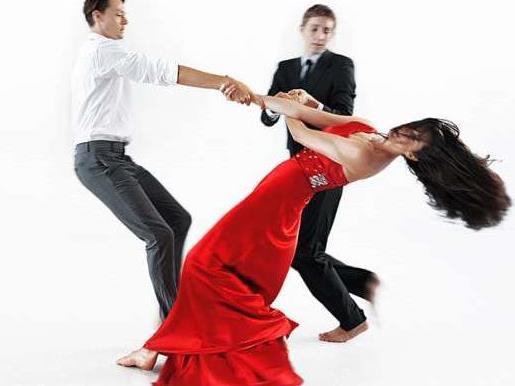A promenade performance from the team led by Michael Whaites and Laura Boynes, Hanging Space maximised the potential of various locations through the Museum, with lighting and choreography making the most of the unique situations.
Beginning in the entrance hall, lights pointed up to an overhead walkway, an industrial beat thumped out and a line of torsos jerked into sight. The ensemble work in the opening piece, Arrive and Depart, was tight. Figures moved with the music, some following the pull of the beat and others doing more free-flowing actions. The limitations of the line of sight of the upwards facing audience were turned into an asset, with some dancers gliding along behind the others, maybe on skateboards? The lack of leg work was partly compensated by the emphasis on hand movements, particularly with the dancers’ fingers coated in bright blue – a feature that continued to draw attention and impress through the night.
From there to Hackett Hall, where we watched from the balcony over a long, large hall. The 9 performers embraced the space, and again performed tightly as a group. Three pieces – Hypnotise, Macro to the Micro and Life Goes On – featured dancers taking turns to perform individual moves with the rest of the group executing repeated, stylised pair and group work elsewhere. The view and the visual effects created for the elevated audience were very impressive, and there was also more use of doonas than expected in a dance work.
Led by a megaphone toting, bossy dancer, we charged back through the museum, through the dinosaurs and minerals, and on to the Beaufort Street stair case. Watching from the top of the stairs, Hanging Space and Evolving/Devolving Species were a feast for the eyes. Using the potential of the different dimensions, neat arrangements of bodies revealed inspired choreography that made the most of the strong cohesion in this ensemble. Brett Smith’s original score for these sections also added to the sensation of driven movement, emphasising the dynamic excitement of the works.
Moving on down the stairs and along a corridor lined with skulls, we arrived in a small, carpeted room and a different experience again. Live music from Tristan Parr combined with an off-kilter projection of abstract images across a corner of the room, creating the artistic space for a movement study in Together. A duet, featuring Emma Harrison and Louise Henshall, fragments of movement repeated against fragments of conversation, all the while lit by magnified images, showing fragments of objects. The music again worked as a compelling force, taking us through to following the departing dancer out the door, through a courtyard and to a garden area.
The final performance took the notion of “hanging space” to another level again, as audience members were invited to lie down on yoga mats arranged on the paving, under some shadecloth sails. Projections on the sails showed the dancers moving about on a tennis court – it was while watching this that one became aware of the same dancers moving in the same patterns between the mats. The highlight was undoubtedly the novelty of having bodies carried over audience members – a perspective I have never enjoyed before. Upside Down and Into the Universe finished with an uplifting sending forth of the performers – a suitable way to end the night.
Despite all dancers working superbly in the ensemble, Joel Small, Megan Exton and Penny Dolling were particularly notable as individual performers throughout the various presentations. While not being any more “showy” than the other dancers, they each had an arresting stage manner that demanded attention even when they were working in with the group.
The technical side of the performance impressed by turning the considerable restrictions of the venue – a lack of traditional theatre infrastructure, a need to quickly move from site to site and a requirement to remove all gear between performances – into a strength. The variety of sound delivery worked with the different spaces as they arose, from intimate cello in a small room to a megaphone in a large hall and dashing through galleries. The acoustics were adapted to the spaces as required, from the vast expanse of the entry hall and walkway to the potentially tricky wooden staircases and the sound design team pulled off the trick of making it work each and every time. The lighting work was no less impressive, not only dealing with the considerations of venue, but also doing what dance lighting is meant to do and it worked sympathetically with the choreography.
Whaites and Boynes have led LINK dance company a merry dance through the Western Australian Museum, impressing us – on many levels – every step of the way.
4 Stars
Hanging Space – dance from a different perspective
Presented by WAAPA and Western Australian Museum
Direction and Concept – Laura Boynes and Michael Whaite
Choreography – The Dancers of LINK in association with Laura Boynes and Michael Whaites
Sound Design – Tristen Parr and Brett Smith
Costume Design and Realisation – Holly Boyton
Lighting Design – Max Wilkie
Head Lighting – Tim Baker
Lighting Crew – Meg Cousins, Amelia Blanco and Cameron Munro
Performed by André Franck Bauer, Anna Kallstrom, Emma Harrison, Joel Small, Katy Geertsen, Louise Henshall, Megan Exton, Mercie Taylor and Penny Dolling





